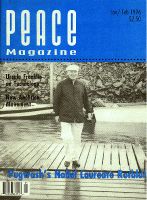
Peace Magazine Jan-Feb 1996, page 31. Some rights reserved.
Search for other articles by Chris Hendry here
Every year Project Ploughshares publishes a summary of the wars it has followed during the previous year. Here are the main features of its 1995 summary, which reflected the 39 wars that had taken place in 1994. May the 1996 survey prove happier than this!
Africa continued to be the most strife-ridden continent on earth, with 14 of its constituent nations involved in varying degrees of conflict. In eight of these (the wars in Burundi, Congo, Ghana, Kenya, Rwanda, Somalia, South Africa, and Zaire) the conflict could be attributed to persistent ethnic clashes. Of these eight, the oldest struggle was the one in South Africa; its immediate origins extend back to 1961. Although the first multiracial elections were held in 1994, clashes between the African National Congress and its rival, the Inkatha Freedom Party, had claimed 15,000 lives since 1990. And of this group of eight countries, the bloodiest one was that of Rwanda, where between 500,000 and one million lives were lost between April and July, 1994.
As for the remaining six African conflicts, civil wars were going on in Sierra Leone, Liberia, and Angola, while conflict along religious lines were being waged in Algeria and the Sudan. In Chad, where a factional struggle had plagued the nation since 1965, gains were made in 1995 as regards its northern border dispute with Libya, but fighting has been responsible for at least 6,000 deaths since 1990.
Meanwhile in Asia, fighting in Burma, Sri Lanka, and Tajikistan were waged along ethnic lines. Religion was the instigating factor behind the wars in the Philippines and India. In the latter state, tensions between Muslims and Hindus still break into violence occasionally in riots that claim thousands of lives. Indonesia persists in waging a war against the East Timorese, whom they had annexed in 1975. Papua New Guinea has been struggling with the secessionist-minded and resource-rich island of Bougainville since 1988--a conflict that resulted in more than 50 deaths in 1994.
Though the Soviets pulled out of Afghanistan as long ago as 1989, the civil war that has been raging there since 1978 still continues between the Mujahideen and the Communist government. In Kabul alone, it claimed at least 8,000 casualties in 1994.
Cambodia also continued to be ravaged in 1994, despite a peace process that the U.N. had established the previous year with an internal governing mechanism. Abandoned land mines from 20 years of fighting still claim lives every day.
The main theme of the European conflicts remains the distressing fervor of nationalism. Here, the names are familiar: Azerbaijan, Bosnia and Herzegovina, Croatia, Georgia, and the war of secession being waged by Chechens in Russia. Already, in the last weeks of 1994, while that war was still new, more than 1,000 people had been killed.
In the United Kingdom blessed progress has been made recently between the British government and the Irish Republican Army toward ending their struggle, but in 1994 they were still actively fighting. A terrorist campaign had been waged since 1969 in the name of unifying Northern Ireland with the Republic of Ireland.
When we turn to Latin America and the Caribbean, we see that civil wars account for all the major conflicts in this region. Haiti, Peru, Colombia, and Guatemala all were experiencing political struggles. The most intense of these was in Guatemala, which has gone on since 1960, claiming between 140,000 and 200,000 lives.
In the Middle East, the final six of the 39 wars could be found. Ethnic struggles were evident in Iran, Turkey, and Iraq, where the governments struggled against Kurdish secessionist forces. Indeed, in Iraq alone an estimated 170,000 Kurds had been killed since 1991. The antagonism between the secular south and the traditional north in Yemen persisted, and so did the fighting in South Lebanon--an area that has otherwise been relatively stable since 1991. Though Israel had been a battleground since it was established in 1947, the mechanism for a lasting peace seems at hand. Even so, over 200 deaths from fighting in this conflict were recorded in 1994.
Unlike publications sold in your local grocery store, we shall not offer a prediction about 1996, except to say that most of the conflicts listed above are still active and will remain topics of more news stories. Yet I, for one, remain hopeful.

Peace Magazine Jan-Feb 1996, page 31. Some rights reserved.
Search for other articles by Chris Hendry here